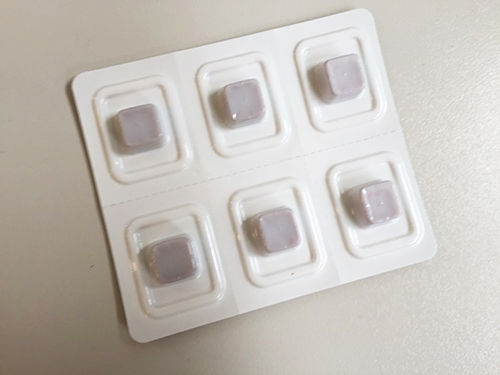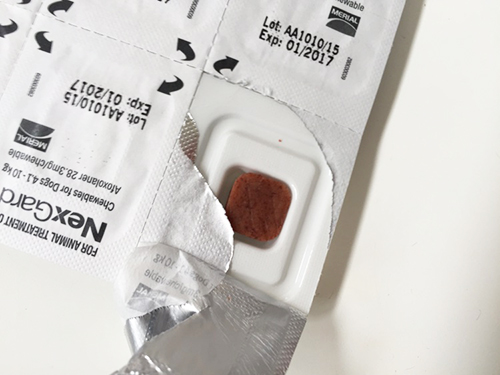NexGard for Dogs
Everything about NexGard chewables

What is NexGard?
NexGard is a medication designed to kill fleas and ticks on dogs. It is also used to treat mange in dogs by controlling the three main mange-causing mites: Demodex mites, Sarcoptes mites and ear mites. NexGard is administered as chew that provides month-long protection against these parasites. It may also aid in the treatment of flea allergy dermatitis.
NexGard is suitable for dogs only and should not be used on cats.
NexGard protects dogs against

Fleas

Ticks

Mites
4 different weight ranges
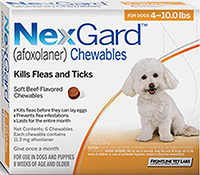 |
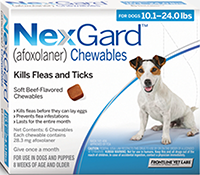 |
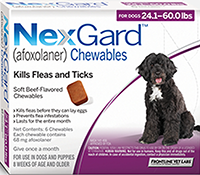 |
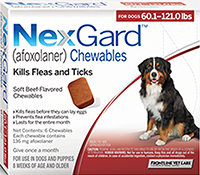 |
|
|---|---|---|---|---|
| Dog Weight (lbs) | 4-10 | 10-24 | 24-60 | 60-121 |
| Dog Weight (kg) | 2-4 | 4-10 | 10-25 | 25-50 |
| Chewable size (g) | 0.5 | 1.25 | 3 | 6 |
| Afoxolaner (mg/chew) | 11.3 | 28 | 68 | 136 |
Active ingredients
NexGard chews contain the active ingredient Afoxolaner, which has been approved by the European Medicines Agency (EMA), Australian Pesticides and Veterinary Medicines Authority (APVMA) and the US Food & Drug Administration (FDA).
Afoxolaner is an ectoparasiticide, meaning it is useful in treating external parasites, those that live on or under your dog’s skin or in the dog’s fur. This type of medication is not used for treating internal parasites such as worms. Afoxolaner works by overstimulating the nervous system of the parasite, resulting in paralysis and death.
The efficacy of Afoxolaner as NexGard has been determined by several field studies, and the benefits have been found to outweigh any associated risks.
In an independent field study involving 146 dogs, a single dose of NexGard was found to reduce the number of ticks and fleas by at least 98% and was effective in treating flea and tick infestations for up to 30 days following treatment.
A separate study saw 31 dogs who had existing demodectic mange treated with NexGard over three consecutive months. The medication was found to reduce the number of live mites on the dogs by 97% after 56 days, and by 98% after 84 days. A third study involved 38 dogs with existing sarcoptic mange treated with NexGard for two consecutive months. This treatment was found to reduce the number of live mites by 96% after 28 days and by 100% after 56 days.
Vs Other Brands
 |
 |
 |
 |
 |
|
|---|---|---|---|---|---|
| Type of Application | Chewable | Chewable | Chewable | Topical | Tablet |
| Fleas | ✔️ | ✔️ | ✔️ | ✔️ | ✔️ |
| Kills newly emerged fleas before they can lay eggs | ✔️ | ✔️ | |||
| Kills 100% of fleas within 24 hours | ✔️ | ||||
| Ticks | ✔️ | ✔️ | ✔️ | ✔️ | |
| Mites | ✔️ | ✔️ | ✔️ | ✔️ | |
| Dosage | Monthly | Every 12 weeks | Monthly | Monthly | Monthly |
Parasites
As a pet owner, you know that dealing with parasites is just a fact of life. Regardless of what part of the world you live in, the climate in your area or what kind of lifestyle you and your dog lead, your pet is always going to be at risk from parasites and the diseases they cause.
Fleas
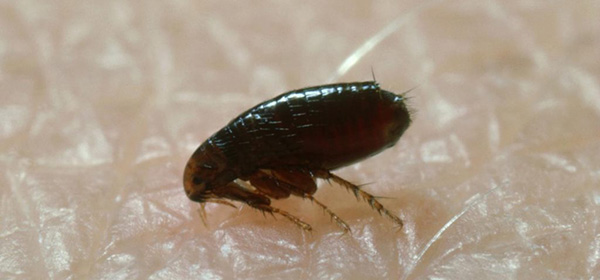
Most of us are all too familiar with the irritation of fleas (Ctenocephalides felis and Ctenocephalides canis). They’re one of the most common parasites found on dogs, due mostly to their worldwide presence and their fast breeding cycle. Fleas are widespread throughout Europe, the Americas and Australia, but can be found in most countries in the world.
Habitat: Fleas love an environment that is moist, warm and out of direct light. In the yard, you can find them in places like woodpiles, garden sheds or under piles of leaves or grass trimmings. Fleas thrive inside the home and inhabit bedding, carpets, soft furnishings and drapery.
Diseases and conditions caused: anaemia, tapeworm, flea allergy dermatitis, Bartonellosis.
Flea life cycle
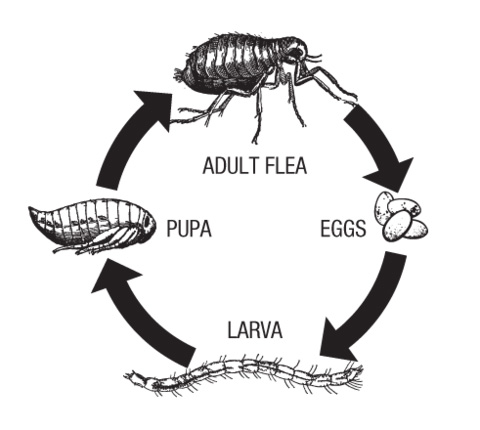
Eggs
These account for around 50% of the population of a flea infestation. An adult female can lay up to 40 eggs per day, usually in the dog’s fur. The unattached eggs fall off the dog and end up in bedding and carpet, where they continue their lifecycle. Eggs take anywhere from 2 to 12 days to hatch, developing more quickly in warm and humid environments.
Larvae
These make up around 35% of the flea population in any home. When larvae emerge from the eggs, they are around ¼ inch long, white and legless. They are also blind and will avoid being in the light. They feed on flea faeces and other organic material in their immediate environment until they are ready to spin a cocoon, usually after 5 to 20 days.Pupae
Around 10% of the flea population will be pupae. This stage takes place entirely within the protective cocoon. In normal conditions, the pupae will develop in a few days to a few weeks, but if the conditions are not optimal for survival, they can remain in the cocoon for months or even years.Adults
These account for just 5% of the flea population, so remember that for every adult you see, there are 10 times as many eggs waiting to hatch. Adult fleas emerge from their cocoons when they sense a potential host, as they need to feed within several hours. Once they have their first blood meal, they can begin breeding within a few days.Ticks
American dog ticks (Dermacentor variabilis)
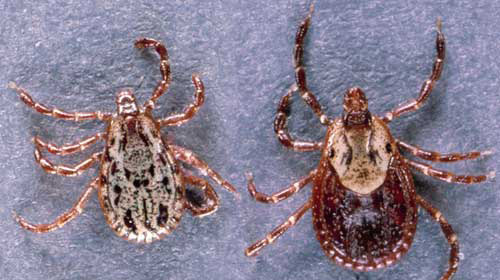
Also known as the wood tick, the American dog tick is native to North America where it is widespread east of the Rocky Mountains and in limited parts of the Pacific Coast. Within these areas, the American dog tick can be found in grassy areas, particularly near woods or alongside trails.
Diseases carried: Rocky Mountain spotted fever, Tularemia, tick paralysis.
Brown dog ticks (Rhipicephalus sanguineus)
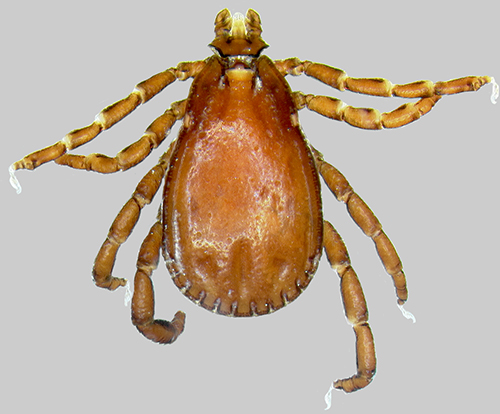
The brown dog tick is found worldwide and is considered to be the most widespread tick. However, it is more prevalent in warmer areas. Unlike other ticks, the brown dog tick can complete its lifecycle indoors and is often found in homes or in kennels, which is why it is sometimes known as the kennel tick. These sheltered habitats mean the brown dog tick can survive through colder times of the year.
Diseases carried: Babesiosis, Ehrlichiosis, Anaplasmosis, Rocky Mountain spotted fever.
Bush ticks (Haemaphysalis longicornis)
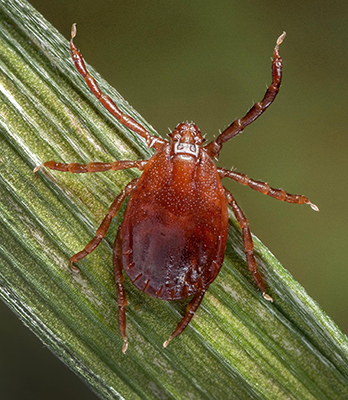
Known also as the Asian longhorned tick or the cattle tick, the Bush tick is originally native to Southeast Asia but is now found in Australia, New Zealand and several Pacific Islands, with reported sightings in the US. Although they predominately feed on cattle, bush ticks also feed on smaller animals including birds, dogs and humans.
Diseases carried: Babesiosis, Ehrlichiosis, anemia.
Castor bean ticks (Ixodes ricinus)
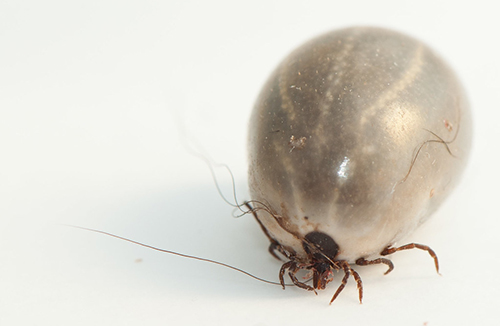
Though mainly restricted to Europe and some parts of northern Africa, these ticks have a wide geographic distribution that covers varied climates, from the Mediterranean areas to Russia and Scandinavia. The castor bean tick is a three-host tick, meaning it requires different hosts at different life stages. The adult ticks require larger hosts and will frequently bite humans. Castor bean ticks are the primary vector for Lyme disease in Europe.
Diseases carried: Lyme disease, Anaplasmosis, Tick-borne encephalitis.
Deer ticks (Ixodes scapularis)
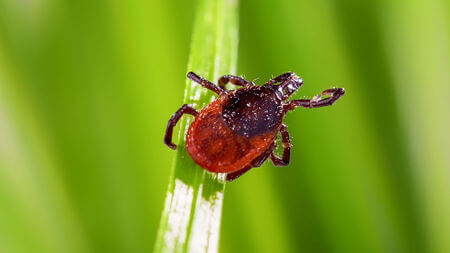
Also known as the black-legged tick, the deer tick is found in North America only, where it can be found primarily in the eastern states and Midwest, along with some parts of Canada and Mexico. The preferred habitat is forested areas but it can also be found shrublands and even leaf piles. As the name suggests, this tick feeds on white-tailed deer, but will also feed on cast, dogs or humans.
Diseases carried: Lyme disease, Anaplasmosis.
Hedgehog ticks (Ixodes hexagonus)
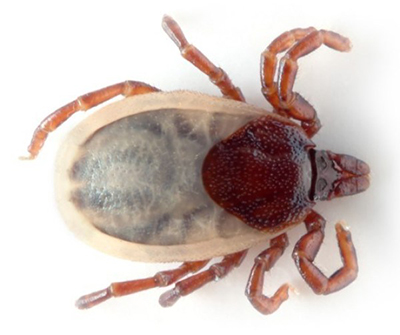
As the name suggests, these ticks can be found wherever there are hedgehogs – primarily throughout western Europe but they have been reported as far east as Siberia. The hedgehog tick inhabits a wide range of environments including forests and caves, but also in urban parks and gardens. Their primary host is the hedgehog, but they are the most common tick found on cats and dogs in Europe.
Diseases carried: Lyme disease.
Lone Star Ticks (Amblyomma americanum)
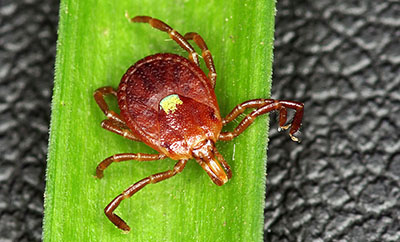
The Lone Star tick is generally restricted to the eastern states of the US, where it can be found inhabiting forested areas with thick undergrowth. The most important thing to note about this tick is that it an aggressive feeder and will actively seek out hosts.
Diseases carried: Ehrlichiosis, Rocky Mountain spotted fever.
Marsh ticks (Dermacentor reticulatus)
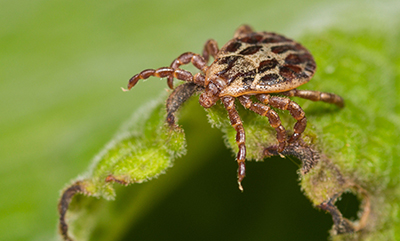
Also known as the Ornate dog tick, the Ornate cow tick or the Meadow tick, the Marsh tick is widespread across Western Europe, with reported populations in some parts of the United Kingdom and western Asia. Marsh ticks feed on most medium-sized mammals including sheep, cattle, dogs and humans.
Diseases carried: Babesiosis, Tularemia, Q Fever.
Paralysis ticks (Ixodes holocyclus)
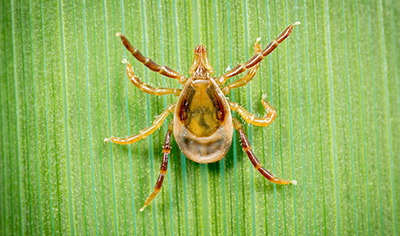
The Paralysis tick is confined to the eastern coast of Australia and is usually found within 20km of the coast itself. Their habitat varies, but are more prevalent in areas with high rainfall. Although these ticks are vectors for disease, the most problematic aspect for pet owners its ability to cause paralysis. When feeding, the tick injects neurotoxins into the host, leading to paralysis and often death.
Diseases carried: Q Fever, tick paralysis.
Tick life cycle
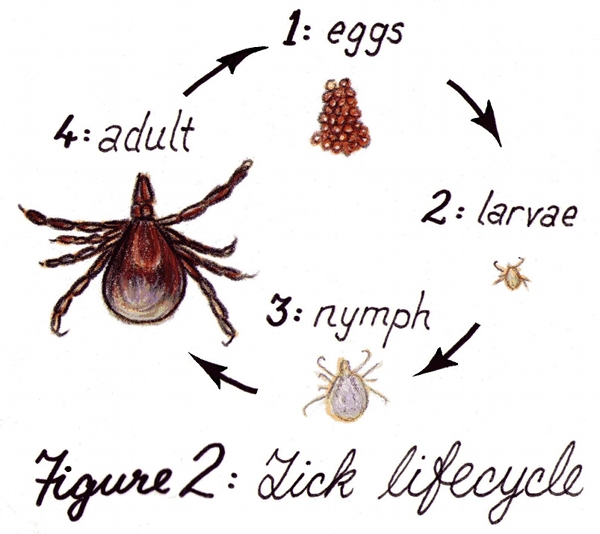
Eggs
All species of tick start their life as eggs, with the adult female laying several thousand eggs at a time. In most cases, the female will drop to the ground to lay her eggs under leaves or hidden in vegetation. Some ticks, such as the brown dog tick, will complete their entire lifecycle without leaving the host. Hard tick females will die after laying their eggs.Larvae
After hatching, the ticks emerge as six-legged larvae, also known as seed ticks. From this point, they will require a blood meal at each stage of development, with many ticks dying when they are unable to find a host. Some ticks feed on the same host at each stage, while others require a new host for each stage – these are known as three-host ticks.
Nymphs
The larvae tick will moult and emerge as an eight-legged nymph, which now looks like an adult tick but smaller. Again, they will require a blood meal before advancing to the next stage of development, but many the nymphs of many tick species can survive up to six months without feeding.
Adults
The final stage of development. In the case of three-host ticks, the adult will seek out a larger animal for their final feed, such as dogs, deer or humans. After feeding, mating can begin, with adult males usually mating with one or two females before dying. Depending on the species of tick, the entire life cycle can take up to three years to complete.
Mites
Demodex mites (Demodex canis)
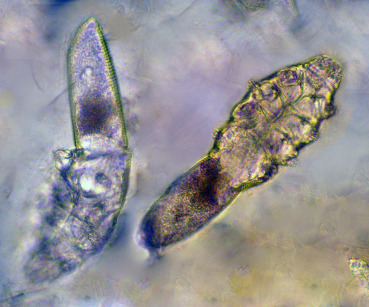
It is actually normal for all dogs to have Demodex mites in small numbers. In normal circumstances, the population remains small and they do not cause any issues. However, in dogs with a compromised immune system, including very old or pregnant dogs, the mites may increase dramatically in number, leading to demodectic mange.
Conditions caused: demodectic mange.
Sarcoptes mites (Sarcoptes scabiei var. canis)
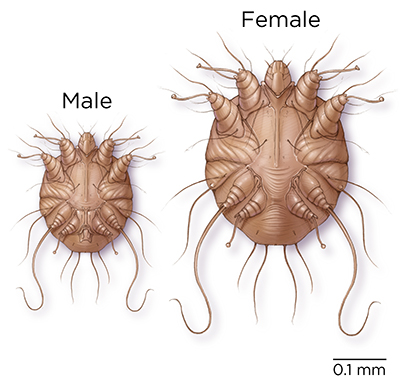
This mite is found in all parts of the world and affects dogs of all breeds and ages. It is highly contagious and passed from dog to dog through direct contact. Once on the host, Sarcoptes mites burrow under the skin, where their movement causes intense itching.
Conditions caused: sarcoptic mange.
Ear mites (Otodectes cynotis)
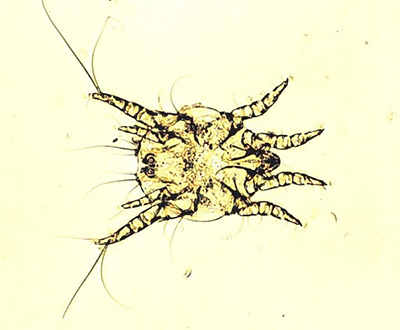
As the name suggests, these tiny creatures live inside your dog’s ear. While an infestation of ear mites is not usually serious, the irritation caused may lead your dog to scratch their ears to the point of causing damage and subsequent infections. Dogs shaking their heads repeatedly may be a sign of an ear mite infestation.
Mite life cycle
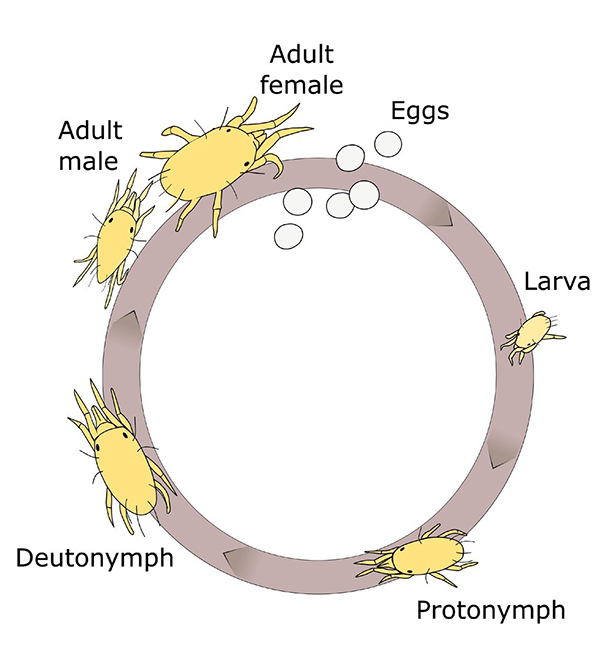
Eggs
As with most parasites, mites start out their life as eggs. Depending on the species, adult females will lay their eggs either on the hair follicles, on the skin or under the skin. Eggs will hatch within 3 to 6 days.Larvae
Mites emerge from the eggs as 6-legged larvae. Eggs that were laid under the skin will make their way to the surface to continue their development. Some species of mite, such as the Demodex mite, go through two larval stages.Nymphs
After going through their larval stage(s), the mites moult to become 8-legged nymphs. At this stage, they may continue their development on the surface, or burrow under the skin. Some species of mite go through two nymphal stages.Adults
Following their final moulting, the adult mite emerges. Mating usually occurs on the surface of the host, though some females will burrow under the skin to lay their eggs. The number of eggs produced is much lower than with other parasites, with some species only laying 1-2 per day, but the survival rate is generally high.Diseases
Anaemia
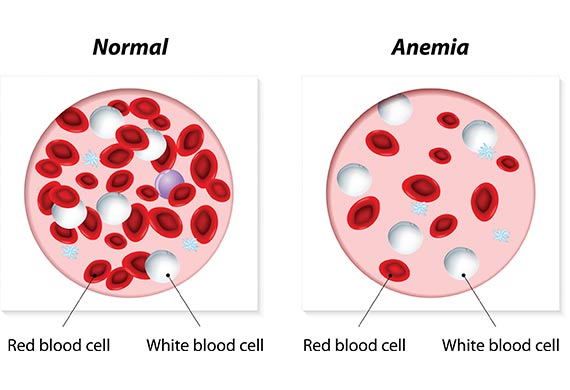
Caused by: fleas, Bush ticks
Anaemia is not technically a disease, but rather the condition of a lower than normal red blood cell count. This occurs when parasites feed on your dog resulting in heavy blood loss. This doesn’t usually affect adult dogs but can be a problem for small dogs or puppies.
Symptoms of anaemia in dogs include:
- pale gums
- lethargy
- weight loss
- rapid pulse
Anaplasmosis
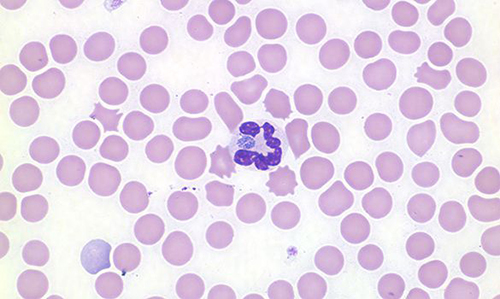
Carried by: Brown dog ticks, Castor bean ticks, deer ticks
This is a bacterial infection caused by the presence of either Anaplasma phagocytophilum or Anaplasma platys, which are usually passed to dogs through the bite of a tick. It is possible for a host to be infected with both strains simultaneously, but A. phagocytophilum is the more common strain.
Symptoms usually appear within 1-7 days and include:
- fever
- loss of appetite
- joint pain
- lethargy
- vomiting
- diarrhea
- respiratory issues
- coughing
- unexplained bruising or bleeding (A. platys)
Babesiosis
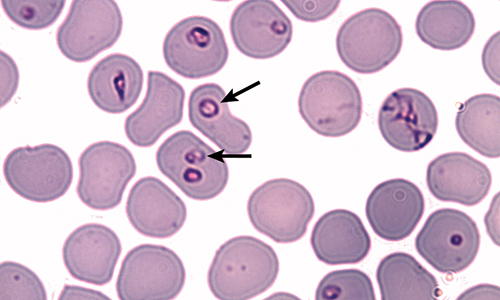
Carried by: Brown dog ticks, Bush ticks, Marsh ticks
Caused by the presence of the bacterium babesia in the blood, Babesiosis can be transmitted in several ways. In dogs, the most common method of transmission is via the bite of a tick that has previously fed on another infected dog. Other methods of transmission include transfer from other to pup while in utero, or via blood transfusions.
Symptoms include:
- loss of energy
- loss of appetite
- pale gums
- fever
- weight loss
- discoloured urine and stools
- enlarged spleen (acute cases)
- swollen lymph nodes (acute cases)
Bartonellosis
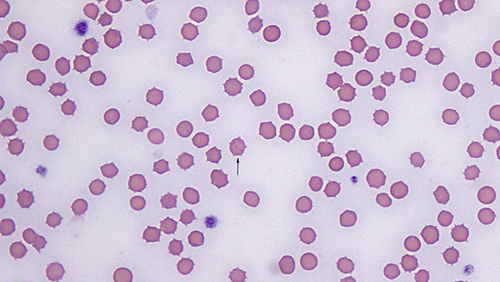
Carried by: fleas, ticks, lice
Also known as cat scratch disease, this is a bacterial infection that can affect a number of animals, including cats, dogs and humans. In humans, it is often transmitted by a bite from an infected cat, but in dogs, it is more likely through the feeding of a parasite including fleas, ticks or lice. Dogs are not the natural host for Bartonellosis and may display no signs or mild symptoms.
These may include:
- lethargy
- vomiting
- fever
- diarrhea
- enlargement of the spleen and liver (acute cases)
- inflammation of the heart, lymph nodes and brain (acute cases)
Demodectic mange
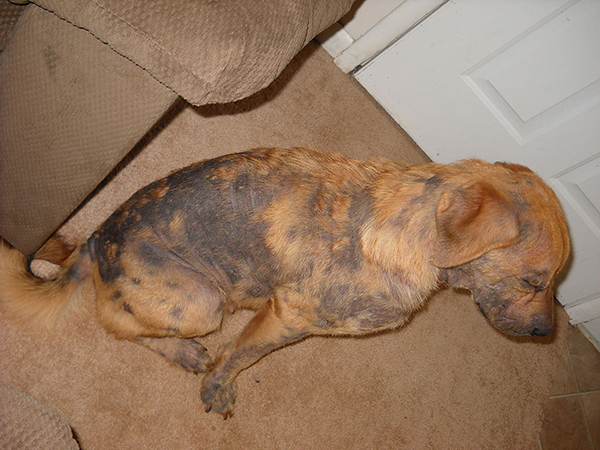
Caused by: Demodex mites
Demodectic mites can be found on most dogs in small numbers without causing any problems, as the body’s immune system keeps the population from increasing. However, in dogs with compromised immune systems, the mites increase to a point where they cause demodectic mange.
Symptoms of demodectic mange include:
- hair loss (localised or entire body)
- red scaly skin
- swelling
- scabs
- infections of the skin
Ehrlichiosis
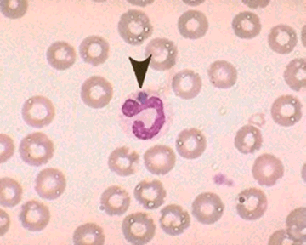
Carried by: Brown dog ticks, Bush ticks, Lone star ticks
Also known as canine rickettsiosis, this is a bacterial disease usually caused by Ehrlichia canis and transmitted exclusively via the bite of an infected tick. The disease affects the white blood cells of the host and is more likely to affect German Shepherds and Doberman Pinschers. The disease goes through three phases, acute, subclinical and chronic, each with different symptoms. (No symptoms present in the subclinical phase.) Prognosis is good if the disease is identified and treated during the acute phase, but dogs that reach the chronic phase may not respond to treatment.
Acute-phase symptoms:
- fever
- swollen lymph nodes
- respiratory distress
- weight loss
- spontaneous bleeding
Chronic stage symptoms:
- anaemia
- haemorrhaging
- swollen limbs
- neurological symptoms
Flea allergy dermatitis
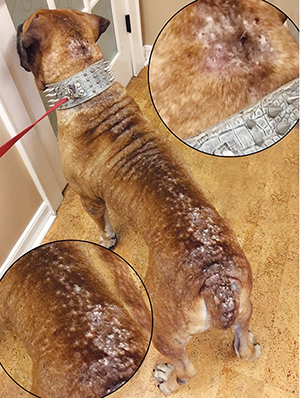
Caused by: fleas
While all animals will feel some irritation from the bite of a flea, some dogs can develop an allergy that leads to flea allergy dermatitis (FAD), also known as fleabite hypersensitivity. This condition is an allergic response to a protein found in flea saliva, which the flea injects as it feeds. Dogs with FAD will experience intense itching from a single flea bite, which may last for weeks.
Symptoms of flea allergy dermatitis include:
- constant scratching or biting
- rash or raw skin
- hair loss, particularly where the bites have occurred
- small raised bumps on the skin
Lyme disease
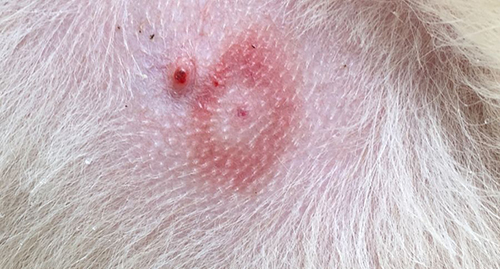
Carried by: Castor bean ticks, Deer ticks, Hedgehog ticks
Lyme disease is one of the most widespread and perhaps well-known tick-borne diseases worldwide. The disease has gained media coverage in recent years as it affects humans as well as animals. In both dogs and humans, the disease is transmitted by the bite of a tick that is infected with the Borrelia burgdorferi bacterium – there can be no direct transmission from dog to human. Lyme disease can be hard to diagnose as the symptoms may take weeks or months to develop, while other dogs display no signs at all. Even after successful treatment, dogs who have been infected with Lyme disease may experience recurring symptoms at a later date.
Symptoms of Lyme disease in dogs include:
- fever
- loss of appetite
- swelling of the joints
- lameness (intermittent, shifting or recurring)
- lethargy
- dehydration
- kidney failure (advanced cases)
Q Fever

Carried by: Marsh ticks, Paralysis ticks, fleas
Technically known as Coxiellosis, Q Fever is caused by the bacterium Coxiella burnetiid and is predominately a disease of livestock. It can be passed easily to domestic animals and humans, with dogs working on farms with sheep and cattle more at risk of catching the disease. Q Fever is highly infectious and can be spread by fleas, ticks and lice – both through bites and the inhalation of the parasite’s faeces. Dogs infected with the disease may take up to one month to display symptoms, which are often very non-specific.
Symptoms of Q Fever in dogs include:
- fever
- lethargy
- depression
- seizures
- stillborn or deformed puppies
Rocky Mountain spotted fever
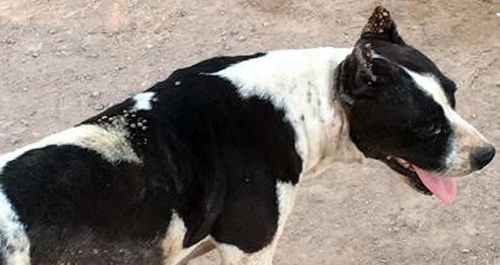
Carried by: Brown dog ticks, American dog ticks, Lone star ticks
As the name suggests, this tick-borne disease originated in the United States near the Rocky Mountains but has now spread as far as Canada and Mexico. Rocky Mountain Spotted Fever (RMSF) is a bacterial disease, caused by the presence of Rickettsia rickettsia. Some breeds are more likely to have a severe reaction to the bacteria, particularly purebred dogs and German Shepherds, but can be dangerous in any breed of dog if left untreated as it affects the nervous system. Humans are also at risk of contracting the disease via tick bite, but there is no direct transmission possible from dog to human.
Symptoms of RMSF in dogs include a fever in the first five days, followed by:
- loss of appetite
- lethargy
- inflamed joints
- swollen lymph nodes
- abdominal pain
- diarrhea
- vomiting
- internal bleeding (advanced stages)
Sarcoptic mange
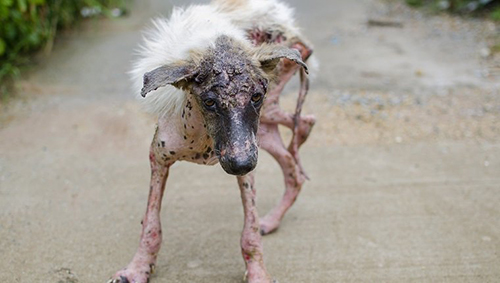
Caused by: Sarcoptes mites
Also known as scabies, Sarcoptic mange is a highly contagious disease that can affect dogs, humans and occasionally cats. Although the sarcoptic mites that cause the condition cannot breed once transmitted to humans, they can cause terrible itching until they die. Transmission between hosts is by direct contact, so if you have more than one dog in your household, one dog contracting the mites will almost certainly mean the other dogs will have it. The mites burrow under the skin where they cause extreme itching, and the subsequent scratching leads to damage, inflammation and infections.
Symptoms of sarcoptic mange in dogs include:
- intense itchiness
- red, inflamed skin
- rashes, scabs and sores
- hair loss
- bacteria and yeast infections
- hardening of the skin (advanced stages)
- swollen lymph nodes (advanced stages)
Tapeworm
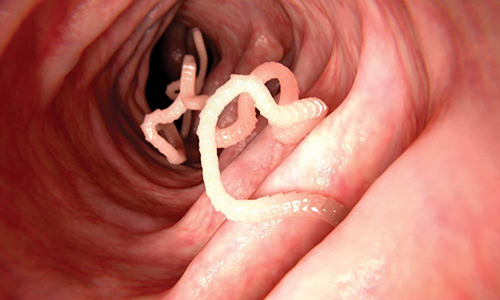
Carried by: fleas
Unlike other intestinal worms, the tapeworm requires an intermediate host to complete its lifecycle, in this case, the flea. The tapeworm eggs are ingested by flea larvae as they feed, developing inside the flea’s body as it matures. During the course of grooming or in response to a flea bite, your dog will ingest the infected flea and with it the tapeworm. Tapeworms do not usually cause serious issues for healthy adult dogs, but can be problematic for young, old or sick dogs.
Symptoms of tapeworm in dogs include:
- scooting
- segments of tapeworm in the faeces
- weight loss (heavy infestations)
Tick-borne encephalitis
Carried by: Castor bean tick
This serious viral infectious disease affects the nervous system, resulting in meningitis, encephalitis or meningoencephalitis. A number of animals including dogs and humans can be affected by tick-borne encephalitis (TBE), though humans usually contract the disease by drinking unpasteurised milk from infected animals. In dogs, the disease is transmitted almost exclusively by the Castor bean tick and is largely contained to Europe. Dogs tend to be more resistant to TBE, but if the disease develops it is usually fatal.
Symptoms of tick-borne encephalitis in dogs include:
- fever
- change in behaviour
- loss of limb control
- seizures
- blindness
- paralysis
Tick paralysis
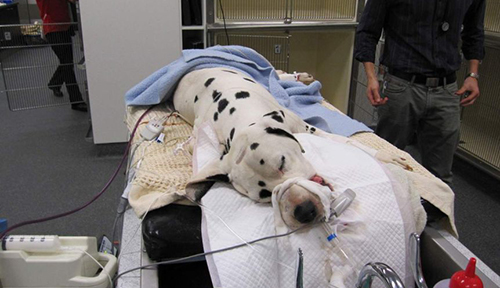
Caused by: Paralysis ticks, American dog ticks
There are actually several ticks worldwide that can cause tick paralysis, but the Australian Ixodes holocyclus causes a much more severe form of the condition than that caused by ticks in other parts of the world. As the ticks feed on the host, which can be dogs, cats or humans, the tick injects a neurotoxin that is produced in the salivary glands. Only female ticks of the species are able to cause tick paralysis. Once the neurotoxin enters the bloodstream, it affects the limbs in ascending order, with symptoms appearing in 2 to 7 days.
Symptoms of tick paralysis in dogs include:
- heavy breathing
- weak rear limbs
- coughing
- changes to bark
- heavy salivation
- collapse
Tularemia
Carried by: American dogs ticks, Marsh ticks
Also known as rabbit fever, Tularemia is most commonly found in rabbits and rodents but can be transmitted to dogs and humans. For dogs, the most common method of transmission is via the bite of a tick infected with the Francisella tularensis bacterium, but they may also develop the disease after eating an infected animal such as a rabbit. Most cases are confined to North America and mainland Europe, where it is widespread. The disease can cause death if not detected and treated early, but mild infections with few symptoms are also common.
Symptoms of Tularemia in dogs include:
- sudden high fever
- loss of appetite
- lethargy
- swollen glands
- stiffness and reduced mobility
- rapid pulse and breathing
Side effects
Side effects of NexGard chews are rare, occurring in less than 1% of dogs studied, but may include vomiting (with or without blood), dry or flaky skin, diarrhea (with or without blood), lethargy or loss of appetite. Recorded side effects are usually short in duration and resolve without treatment.
Pet owners should be aware that afoxolaner is part of the isoxazoline family of drugs, which can cause issues for dogs with epilepsy or seizures. Consult your veterinarian before administering NexGard if this applies to your dog.
Overdose with Afoxolaner can occur if giving a small dog a chew that is intended for a larger dog. If you suspect an overdose has occurred, please contact your vet immediately.
Precautions
Anyone purchasing, storing or administering NexGard chews should take the following precautions:
- Do not remove the chew from the blister packet until immediately prior to administration
- Keep this and all medication out of reach of children and other animals
- Wash your hands after handling the product
- Dispose of the empty package by wrapping in paper and placing in the garbage
- Store away from light
- Store below 30C/86F (room temperature)
Our review
Package contents
Afoxolaner is sold under the name NexGard in all markets, so your package should be sold with this branding regardless of where you are.
NexGard chewables are available in packets of 3, 6 or 12. You will see that the packages have different colours, this is to indicate the size of the dog that the chews are suitable for. NexGard is available for four different weight ranges, with dogs over the maximum weight range requiring a combination of chews.
Inside the cardboard packet, you’ll find a blister pack containing the chewables. Depending on the size of your dog, the chewables will be round, square or rectangular.
Application
NexGard has been created as a beef flavoured chew that can be given to your dog as a treat – it does not need to be given with food. Most dogs find the smell and taste attractive, and should accept and chew the medication without issue.
It does need to be chewed to be the most effective, so for dogs that have a tendency to swallow treats whole, the NexGard may need to be broken into smaller pieces before being offered. For dogs that refuse to take the chew, you can break it into pieces and mix it with their food.
Pros
- Full month protection against external parasites
- Oral formula means no messy application
- Dogs can be bathed or go swimming immediately after application
- No risk of skin reactions as with topical medications
- Chewable texture is good for dogs that can’t swallow tablets
Cons
- Does not protect against internal parasites
- Cannot be used on pregnant or breeding dogs
- Some dogs may be sensitive to the active ingredient
FAQs
How do I administer NexGard?
How long does it take NexGard to kill fleas?
Can I give NexGard to my cat?
Can I divide NexGard chews to give to more than one dog?
Where to buy
 |
 |
 |
|
|---|---|---|---|
| Score | ⭐⭐⭐⭐⭐ 5/5 | ⭐⭐⭐ 3/5 | ⭐⭐ 2/5 |
| Price of NexGard Chewables | From $66.95 | From $79.95 | From $76.95 |
| Free worldwide shipping | ✔️ | ❌ | ❌ |
| Shipping time | 3-7 business days | 14-20 business days | 10-15 business days |
| Auto-delivery option | ✔️ | ✔️ | ✔️ |
| Accepts return | ✔️ | ✔️ | ✔️ |
| 24/7 support | ✔️ | ❌ | ❌ |
| Wide range of products | ✔️ | ✔️ | ✔️ |
| Loyalty program | ✔️ | ❌ | ✔️ |
| User-friendly storefront | ✔️ | ✔️ | ✔️ |
| Multilingual storefront | ✔️ | ❌ | ❌ |
| Customer reviews | 5/5 1271 reviews | 2.7/5 1328 reviews | 3.6/5 870 reviews |
| Shop Now | Shop Now | Shop Now |
User Reviews
Have you treated your dog with NexGard chewables? Let us know how the experience was!
